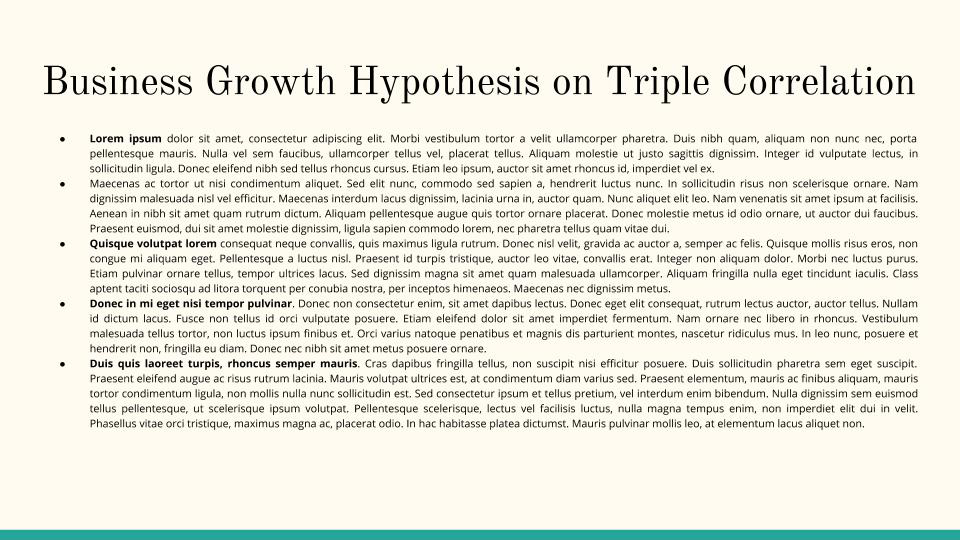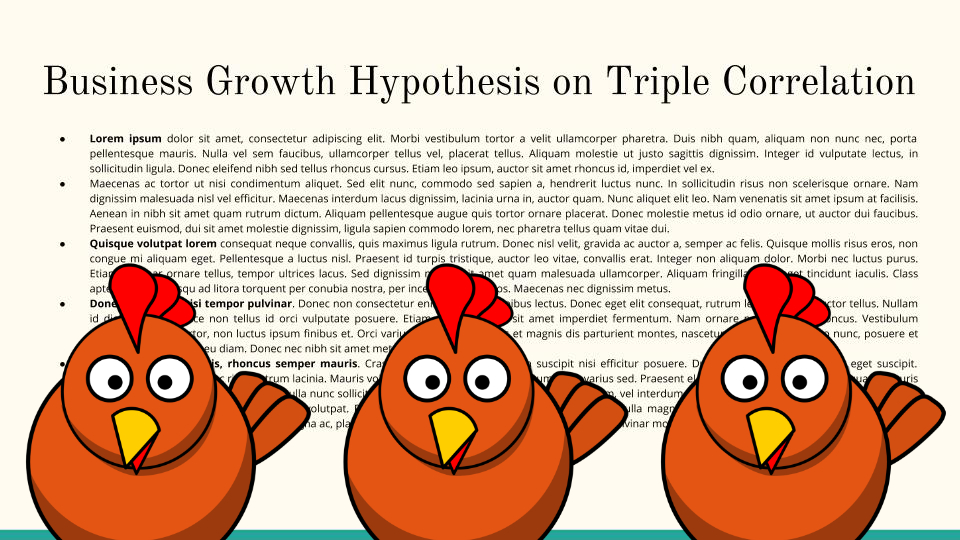Do you remember that day — probably a rainy one — when you sat in a conference room? Your heart was filled with eagerness to dive into the speaker’s mind. You even prepared by documenting about the topic, to fully comprehend the genius striding in front of you.
The common purpose
And then, as the drama unfolded in the room and the rain kept pouring outside, this slide came up:
“Oh dear”, you whispered, “Not again… Not this Powerpoint presentation…". You know it when you see it. The Powerpoint to end all Powerpoints. The one with slides so dense, that a pair of opera-binoculars should be provided on each chair.
Yes my friend, you’re about to spend a long, excruciating hour. You’ll watch the speaker spit 3 zillion data per minute, while your brain turns into a mishmash of tears, agony, and forgotten eastern curses inherited from your mother side. Who would have guessed that these memories could be retrieved? Bonkers!
I call this phenomenon the Chicken Hypnosis, or the Gallus Gallus Apathy — Latin makes things so chic —. We have all seen dozens of Powerpoint presentations where you ask yourself: What is the point of this Powerpoint? To help the speaker or to hypnotize chickens, namely, the audience?
The real purpose
Much ink has been spilled on the Powerpoint issue: Back in 2003, the NASA pointed that Powerpoint makes you dumb, some physicists chose to ban Powerpoint altogether and searching for “Powerpoint hate” on Google yields 24 400 000 results.
But still, (almost) everybody uses a form of Powerpoint to do a presentation. It can’t be for nothing! Indeed, I believe that a Powerpoint has a great purpose: to support the speaker. To provide some anchor, in the turmoil of a long explanation.
A Powerpoint purpose is 2-folded:
- Condense information in a digestible format to sum important points
- Provide multimedia content to animate the presentation
But, what really matters is the explanation of the speaker. Filling slides up to death is an innocent act of laziness, not malevolence.
How did we get there?
Tool & User
I think Powerpoint is a very efficient tool. Without any prior knowledge, you can put together titles, bullet points and incredible-yet-utterly-useless animations.
However, who is using Powerpoint? For the vast majority, people who are not professional speakers (me too!). They are business men, developers, physicists, or anything that is not directly centered on a Speaker / User Experience. For them, making a presentation is mandated by their job, but they surely didn’t study to do presentations or animate conferences.
Mix the ease of use of Powerpoint with the lack of interest of its users, and you get this new Super-Villain: The Destroyer Of Minds (DOM for the closest friends).
Misuse of the Tool
From here, the resulting presentation has many chances of being failed. We already covered the densely-packed slides, but there’s another killer hiding in plain sight: The lifeless presentation.
Everything feels empty. There can be a lot on each slide… Or not. The speaker is slow and monotonous. Add a last slide, and the abyss will swallow you in the eternal bliss of infinite boredom.
In this case, the Powerpoint has taken the driver seat. The trigger to speak is the “Next Slide Button” — not what the speaker intends to say.
Down the Rabbit Hole
It gets even worse. To be so easy to use, Powerpoint has a killer-feature: The Bullet Point.
It might seem innocuous, but I think it’s exactly the reason for which presentations get such a bad press: it transforms complex ideas into a sequence of bullet points, waiting to be unstacked, one by one.
A presentation can have multiple purposes: make you think, spark a heated debate, provide a different perspective on a known issue.
A set of bullet points is a drowning of creativity. Said plainly, you cannot express complex ideas with bullet points. It’s like describing a car with karate moves: it’s not meant for that.

"Here are the seats, and you can lower the windows like so." — Damn, this picture could almost make the opposite point! Note to self: choose a worse karate picture.
Still, why do we cram so much data in our slides? Because we have the illusion that the audience must know everything. WRONG! 90% of the time, you are presenting your deep work to people who might not have the slightest idea of your passion.
They are just curious / forced to be here / bored / sitting in the wrong conference room.
Oh dear, this is about the Java programming language? I’m just a Peruvian Coffee Beans aficionado!
How should we approach it?
You might yell at me:
“Very well then, should I empty my slides? Fill them? Simplify everything? Put only complex diagrams?"
Breath. I understand. You think about that presentation you already hated even before finishing it. We all have been culprit of such an abomination.
I will calmly answer with 2 questions: Who is your audience? What are your constraints?
If you can’t answer, the presentation is already doomed. Call it a day and start doing some improv class, you’ll have better chances.
Is your audience young children, discovering science? International astrophysists waiting for your Boson revelation? Do you have 20 mins or 2 hours? Can you draw something while talking? Is it online or in a real room, with real people?
This is going to determine the shape and content of your presentation. Who cares if you used a distributed micro-service architecture if your audience can’t tell the difference between Internet and Google Chrome?
If the answer to these questions keeps Powerpoint in the race, I can see 2 possible presentation general “shapes”.
TBP aka The Big Presentation
You give an important talk, on a topic you have been working on for months / years. By God, reduce the load per slice, add schemas and animations to make it easier to grasp the idea. Yes, use bullets point to sum up and the end of a section, but not to articulate a complex topic.
Your hard work deserves a proper presentation. It would be a shame to flush your years-long sweat in the toilet of “Slides Mediocrity”. Your audience will probably not have the same depth as you do. And if they do, the questions is the perfect time to dig in.
If you already know you’re dealing with specialists, add references, data, but remember: YOU are the reason they’re wasting their life in this small room for an hour. Not your slides. Not your fancy animations.
Machine-gun Slides
If you have (like myself in recent instances) have to produce hundreds of slides on a topic, you have to be efficient rather than beautiful.
Getting your point across without spending 2 hours on each Powerpoint can make a difference. Again, know your constraints and deal with it.
Some people have such a mastery of the content that the Powerpoint becomes a character of the presentation. For example, Larry Lessig, with his “Lessig Method” is known to fire many, many slides for a single presentation. And it works!
A tool — nothing more, nothing less —
Everyone has a love / hate relationship with Powerpoint. In the end, it’s just a tool. Like any tool, it can be properly used and misused.
Because it’s easy to start with, you can dump your Ph.D thesis in your slides. Job done, back to real work. Not so fast!
Your presentation is a part of your work. Don’t spoil it by doing a cheap stunt. You deserve better.
Powerpoint is a tool, not the tool. When you only have a hammer, every problem looks like a nail.
Surrendering is transforming yourself into a nail, while Powerpoint is happily smashing on you.
Surrendering, is transforming your audience into chickens.
You’re not a Nail nor a Chicken. You’re a Human. Embrace it.





